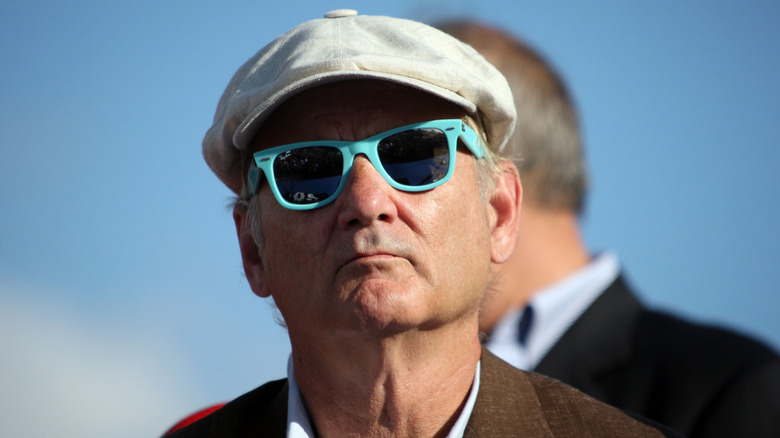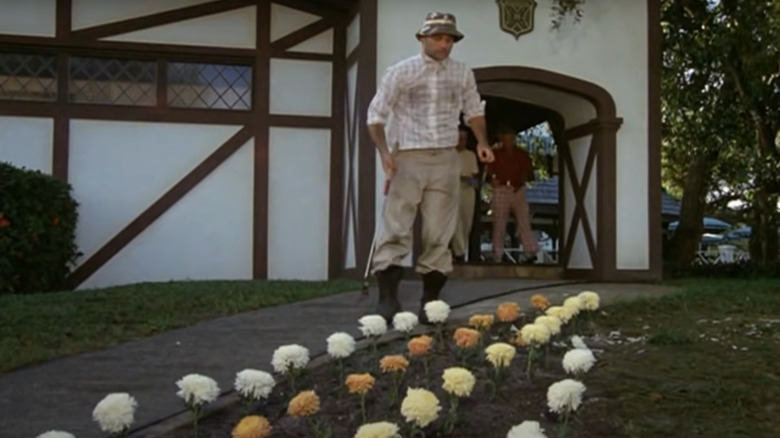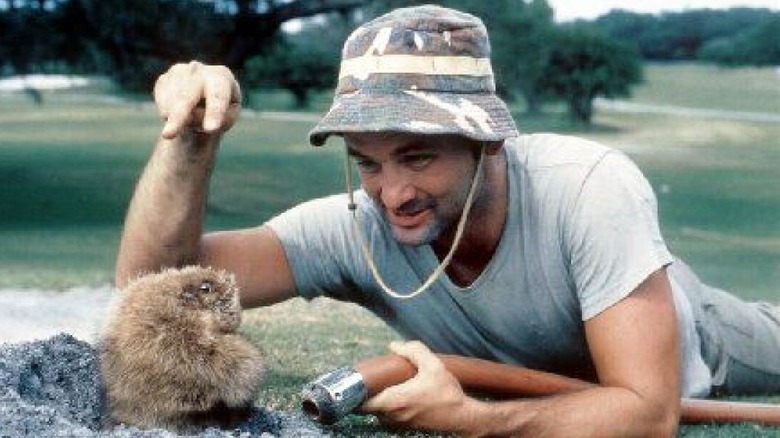One Of Bill Murray's Best Movie Moments Was Made Up On The Spot
When it comes to golf movies, one stands a gopher's head and shoulders above the rest: "Caddyshack." The 1980 slapstick comedy starring Chevy Chase, Rodney Dangerfield, and Bill Murray pits the white-collar snobs against the working class slobs charged with being at their beck and call at the ritzy Bushwood Country Club. ESPN ranks "Caddyshack" in their top 10 all-time sports movies, and the highest-ranked golf movie.
The movie seemed to be an accidental success. "Caddyshack" had a first-time director in Harold Ramis. The film's top stars were known mostly for TV's "Saturday Night Live" with Chase and as a standup comedian in Dangerfield. But just like every sports movie needs an unlikely hero, "Caddyshack" had their own Cinderella story in the making with Bill Murray.
Despite the many memorable performances from "Caddyshack," it was Murray that stole the show as quirky groundskeeper Carl Spackler. What's even more impressive is that he did by ad-libbing entire scenes, including the most memorable of the entire film.
Murray wasn't a big part of the movie
The story of "Caddyshack" is documented in Chris Nashawaty's 2018 book "Caddyshack: The Making of a Hollywood Cinderella Story." Golf Magazine features excerpts from the book, which explains why the movie was never supposed to become a classic. Initially, Bill Murray's character Carl Spackler wasn't a big part of the movie. Murray was only scheduled for a week of shooting on the three-month production. But once Murray went to work on the character, the writers expanded the character's role.
As a veteran of Chicago's Second City improvisational comedy troupe, "Caddyshack" director Harold Ramis encouraged ad-libbing on the film. That freedom given to his actors is what allowed for the film's most memorable scene. Nashawaty writes:
"For some actors, that sort of freedom can be paralyzing. For others, like Bill Murray, it's liberating. Murray's most famous scene in Caddyshack is his epic tale of looping for the Dalai Lama – 'Big hitter, the Lama' – but his longest scene in the film is the famous 'Cinderella Story' monologue. And it's a scene for which no lines were ever actually written. It sprung sui generis from Murray's head. Before rolling the camera, Ramis huddled with Murray and gave the actor some motivation."
Ramis considered improvisation an acting technique that allows actors to create material instantly rather than grabbing it out of thin air. Before the Cinderella story scene, Ramis asked Murray if he ever did imaginary golf commentary in his head, and Murray responded, "Yeah, yeah, yeah, don't say anymore. I got it!" The result was a monologue for the ages.
The entire movie was improvised
Murray's exceptional performance changed the trajectory of the whole film. Because he was only scheduled for a week, Ramis and Murray brainstormed ideas for Carl Spackler and then Ramis would later find places for them in the film. Ramis said, "Everything we shot with Bill in the movie was just him riffing. We just described the physical action and he made up the lines." It was a brazen move by a novice filmmaker, and it paid off.
Like Murray, the course-destroying gopher also played a small role in the original script. But because many of the new scenes featured Spackler constructing inventive ways to kill the gopher, it became a bigger storyline. Murray would later joke that the movie was his Vietnam, saying:
"The ridiculously inappropriate firepower I used to kill a small rodent. And a guy who was taking it all personally and it didn't have anything to do with him. Carving those clay bombs of the rabbit and the squirrel, that stuff, you're just amusing yourself. And if I'm making myself laugh and making these guys laugh, then it's funny."
Fittingly, the entire production of "Caddyshack" seemed to mirror Murray's performance. The final version of "Caddyshack" barely resembled the shooting script, with revisions, additions, and some pages just tossed in the trash. Ramis' love of improvisation showed in his style of filmmaking, and it inspired one of the most memorable sports movies — and scenes — of all time.


